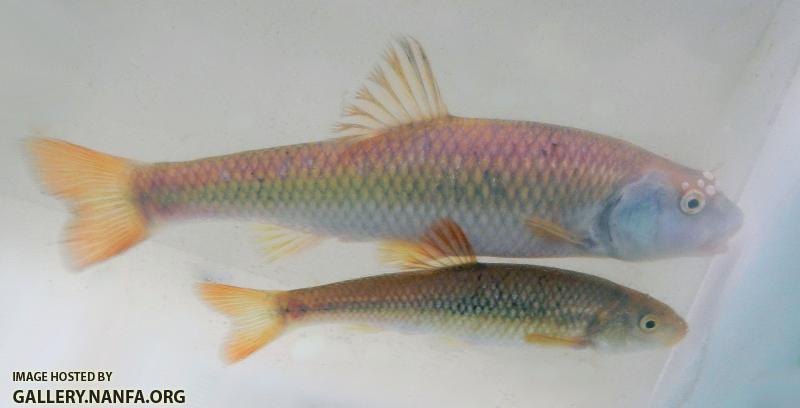Am I correct in thinking that they show up in random amounts as the breeding season progresses, kind of popping up like pimples one or two at a time, until they reach their full amount?
I'm curious, because I wanted to verify the subspecies of this fella I posted yesterday. He's only got six, very geometrically-spaced, tubercles.
http://forum.nanfa.o...-is-in-the-air/
N.l. interocularis is the in-range subspecies for this stream (Little River, McCormick Co., SC) and his tubercles are very much interocularis, but he should have 7-9. N. l. bellicus is way out of range for here, but is the only subspecies that might have 6 tubercles.
Is he not yet up to full breeding mode and still waiting to bust out a couple more tubercles? Does he have the full complement and I'm just missing it?

Nocomis leptocephalus tubercles
Started by
mattknepley
, Apr 02 2014 05:32 AM
5 replies to this topic
#1

Posted 02 April 2014 - 05:32 AM
Matt Knepley
"No thanks, a third of a gopher would merely arouse my appetite..."
"No thanks, a third of a gopher would merely arouse my appetite..."
#2
 Guest_gerald_*
Guest_gerald_*
Posted 02 April 2014 - 10:33 AM
Based on blueheads I've seen, they seem to get more tubercles as they get bigger and older, like beard hair on young men. Not sure if they grow more tubercles within a season, or just year-to-year. When the tubercles recede in late summer, they leave a permanent tubercle scar. I assume next year's tubercles emerge in the same places (plus any new ones) but I'm not really sure about that either. Would be interesting to mark and photograph the same males year after year (either wild or captive) and see what happens.
#3

Posted 02 April 2014 - 02:34 PM
" they seem to get more tubercles as they get bigger and older"
That makes more sense than what I was thinking. This guy didn't appear to be full grown, so I bet you're right. Maybe we need to put some of our resident fishtographers on the case.
That makes more sense than what I was thinking. This guy didn't appear to be full grown, so I bet you're right. Maybe we need to put some of our resident fishtographers on the case.
Matt Knepley
"No thanks, a third of a gopher would merely arouse my appetite..."
"No thanks, a third of a gopher would merely arouse my appetite..."
#4

Posted 02 April 2014 - 04:43 PM
As I am often trying to remind people, size is not everything... this guy was only about 5 or 6 inches in a very small stream from out Stone Mountain day... 
but he was mound building, impressing the ladies (especially this one), spawning and creating the yellowfin fire...
And although I don't have a straight on head shot, I think he only has a couple more tubercules... kinda the same as your guy but with a couple more small ones over/behind the eye. ANd actually if I look real close at your picture it kinda seems like your fish has a tubercule coming or a scare form a previous year right behind his eye also...
but he was mound building, impressing the ladies (especially this one), spawning and creating the yellowfin fire...
And although I don't have a straight on head shot, I think he only has a couple more tubercules... kinda the same as your guy but with a couple more small ones over/behind the eye. ANd actually if I look real close at your picture it kinda seems like your fish has a tubercule coming or a scare form a previous year right behind his eye also...
Either write something worth reading or do something worth writing. - Benjamin Franklin
#5

Posted 02 April 2014 - 07:13 PM
You've got a point on the size thing, Michael. It's hard to remember that the size range listed in the guides are sizes of the adult, and can vary. It does look as if he's got maybe another tubercle coming in behind the eye. That would put him in the "proper" count too. Will have to see if I have shots of the rest of his head.
Matt Knepley
"No thanks, a third of a gopher would merely arouse my appetite..."
"No thanks, a third of a gopher would merely arouse my appetite..."
#6
 Guest_blakemarkwell_*
Guest_blakemarkwell_*
Posted 02 April 2014 - 08:41 PM
Yes, tubercles increase in distribution and number with growth, although I've heard certain species attain their adult complement of tubercles, or at least an indication of tubercle development, as juveniles (I can't remember which, if any, species were mentioned). In addition to being deciduous postnuptially, they can also loose them from agonistic behavior.
You should be able to get a pretty accurate count if you look closely for tubercle spots (juveniles and females, which are hard as hell to see from what I've read), buds (males and some females), mature tubercles, and scars.
You should be able to get a pretty accurate count if you look closely for tubercle spots (juveniles and females, which are hard as hell to see from what I've read), buds (males and some females), mature tubercles, and scars.
1 user(s) are reading this topic
0 members, 1 guests, 0 anonymous users









